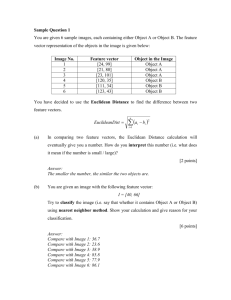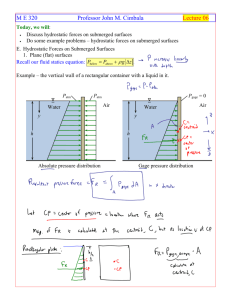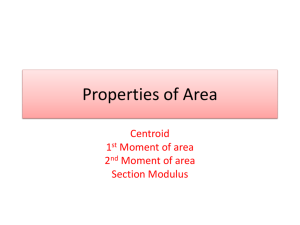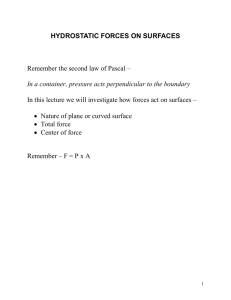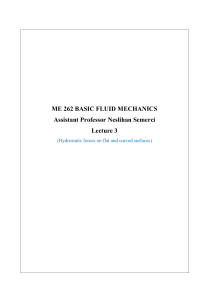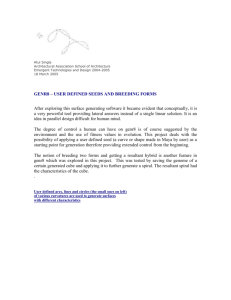Fluid Statics (surface forces)
advertisement
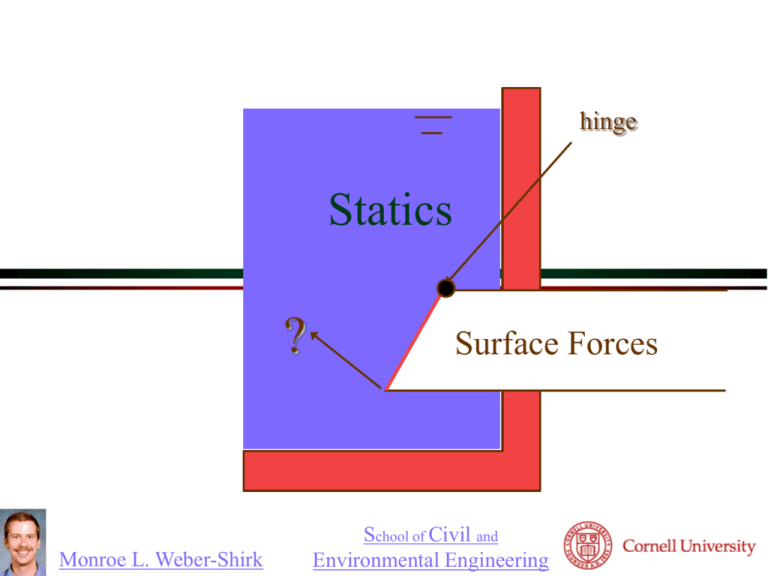
hinge Statics ? Monroe L. Weber-Shirk Surface Forces School of Civil and Environmental Engineering Static Surface Forces Forces on plane areas Forces on curved surfaces Buoyant force Stability submerged bodies Forces on Plane Areas Two types of problems Horizontal surfaces (pressure is _______) constant dp p a Inclined surfaces g Two unknowns dz Total force ____________ Line of action ____________ Two techniques to find the line of action of the resultant force Moments Pressure prism Forces on Plane Areas: net Horizontal surfaces P = 500 kPa What is the force on the bottom of this tank of water? gage FR pdA p dA pA FR g hA p = gh = volume FR = weight of overlying fluid! h What is p?Side view FR h = _____________ Vertical distance to free surface _____________ F is normal to the surface and towards the surface if p is positive. F passes through the ________ centroid of the area. p p a ax 0 x A Top view Forces on Plane Areas: Inclined Surfaces Direction of force Normal to the plane Magnitude of force integrate the pressure over the area pressure is no longer constant! Line of action Moment of the resultant force must equal the moment of the distributed pressure force Forces on Plane Areas: Inclined Surfaces y FR pc A g pc q x yR center of pressure Where could I counteract pressure by supporting potato at a single point? y centroid xR The coordinate system origin is at the centroid (yc=0) Magnitude of Force on Inclined Plane Area FR pdA Change in pressure due to change in elevation g y q p pc gy cosq FR pc dA gy cosq dA A A FR pc A g cosq ydA A FR pc A òydA = 0 for y origin at centroid A centroid of the area pc is the pressure at the __________________ First Moments A Moment of an area A about the y axis xdA 1 xc xdA A A 1 yc ydA A A Location of centroidal axis Plate thickness yc gAt y gtdA A 1 h 3 For a plate of uniform thickness the intersection of the centroidal axes is also the center of gravity Second Moments moment of inertia of the area Also called _______________ I x y 2 dA Could define i as I/A… A I x I xc Ayc2 Ixc is the 2nd moment with respect to an axis passing through its centroid and parallel to the x axis. The 2nd moment originates whenever one computes the moment of a distributed load that varies linearly from the moment axis. Product of Inertia A measure of the asymmetry of the area I xy xydA A Product of inertia I xy xc yc A I xyc Ixyc = 0 Ixyc = 0 y y x x If x = xc or y = yc is an axis of symmetry then the product of (the resulting force will pass through xc) inertia Ixyc is zero.______________________________________ Properties of Areas b Ixc Ixc a yc ab yc A 2 a b d Ixc A ab R yc a yc 2 a yc 3 bd xc 3 A R 2 yc R I xc 3 ba 12 I xyc 0 3 ba I xc 36 I xc R4 4 I xyc I xyc I xc a 2 A 12 ba 2 b 2d 72 I xc a 2 A 18 2 I R 0 xc A 4 Properties of Areas Ixc yc A R R2 2 4R yc 3 R 4 I 0 I xc R 2 I xc xyc 8 A 4 b a yc Ixc R yc A ab A R2 4 yc a 4R yc 3 I xc ba I xc 3 4 R4 16 I xyc I xc a 2 0 A 4 I xc R 2 A 4 Forces on Plane Areas: Center of Pressure: xR The center of pressure is not at the centroid (because pressure is increasing with depth) x coordinate of center of pressure: xR xR FR xpdA A Moment of resultant = sum of moment of distributed forces p pc gy cosq FR pc A 1 xR xpdA A FR 1 xR x pc gy cosq dA A pc A 1 1 xR xpc dA x gy cosq dA pc A A pc A A Center of Pressure: xR 1 g cosq xR xdA xydA AA pc A A I xyc xydA For x,y origin at centroid A 1 xdA 0 A A xR g cosq I xyc pc A xR is zero if the x axis or y axis is a line of symmetry Center of Pressure: yR y R FR ypdA Sum of the moments A 1 yR ypdA FR pc A A FR 1 yR y pc gy cosq dA A pc A yR 1 1 2 yp dA gy cosq dA c pc A A pc A A 1 g cosq yR ydA A A pc A A y 2 dA p pc gy cosq g Center of Pressure: yR FR 1 g cosq 1 2 yR ydA y dA A A pc A A I xc y 2 dA 1 ydA 0 A A g cosq I xc pc g cosq g y For y origin at centroid A yR q yR A yR FR I xc g cosq Location of line of action is below centroid along slanted surface. │yR │ is distance between centroid and line of action The moment about the centroid is independent of pressure! Location of average pressure vs. line of action 0 1 2 3 4 5 6 7 8 9 10 What is the average depth of blocks? 3 blocks Where does that average occur? 5 Where is the resultant? Use moments yR FR 1m 4blocks 3m 8blocks 5m 12blocks 7m 16blocks 9m 20blocks yR FR 380m blocks 380m blocks yR 6.333m 60blocks Inclined Surface Findings The horizontal center of pressure and the horizontal centroid ________ coincide when the x or y axis is a line of symmetry for the surface The center of pressure is always _______ below the centroid The vertical distance between the centroid and the center of pressure _________ decreases as the surface is lowered deeper into the liquid The center of pressure is at the centroid for horizontal surfaces 0 xR g cosq I xyc pc A >0 yR g I xc pc A cos (90) = 0 cosq Example using Moments An elliptical gate covers the end of a pipe 4 m in diameter. If the gate is hinged at the top, what normal force F applied at the bottom of the gate is required to open the gate when water is 8 m deep above the top of the pipe and the pipe is open to the atmosphere on the other side? Neglect the weight of the gate. teams Solution Scheme -Magnitude of the force applied by the water hinge 8m Location of the resultant force Find F using moments about hinge water F 4m Team Work How will you define a coordinate system? What is the pressure datum? What are the major steps required to solve this problem? What equations will you use for each step? hinge 8m water F 4m Magnitude of the Force g y Pressure datum? _____ atm Y axis? FR pc A 8m A ab water q FR F hc = _____ 10 m Depth to the centroid g hc pc = r___ a = 2.5 m FR ghc ab kg m FR 1000 3 9.8 2 10 m π 2.5 m 2 m m s FR= ________ 1.54 MN b=2m hinge 4m Location of Resultant Force g yR g I xc cos q pc A 4 5 cos q 8m g hc pc = r___ water FR F hinge 4m I xc a 2 4 A a = 2.5 m g a2 4 yR ghc 4 5 a2 yR 0.125 m 5hc cp 0 xR __ b=2m Force Required to Open Gate g How do we find the required force? 8m Moments about the hinge M hinge 0 =Fltot - FRlcp F water FR F hinge 4m FR lcp ltot lcp=2.625 m 2.5 m 1.54 x 10 N 2.625 m F cp 6 5 m F = ______ 809 kN b=2m ltot Forces on Plane Surfaces Review The average magnitude of the pressure force is the pressure at the centroid The horizontal location of the pressure force gate was symmetrical was at xc (WHY?) The ____________________ about at least one of the centroidal axes. ___________________________________ The vertical location of the pressure force is Pressure below the centroid. (WHY?) ___________ increases with depth. ___________________ Forces on Curved Surfaces Horizontal component Vertical component Tensile Stress in pipes and spheres Forces on Curved Surfaces: Horizontal Component What is the horizontal component of pressure force on a curved surface equal teams to? (Prove it!) The center of pressure is located using the moment of inertia technique. net The horizontal component of pressure force on a closed body is _____. zero Forces on Curved Surfaces: Vertical Component What is the magnitude of the vertical component of force on the cup? F = pA h p = gh F = ghr2 =W! r What if the cup had sloping sides? What if the cup bottom were a hemisphere? Forces on Curved Surfaces: Vertical Component The vertical component of pressure force on a curved surface is equal to the weight of liquid vertically above the curved surface and extending up to the surface where the pressure is equal to the reference pressure. Example: Forces on Curved Surfaces Find the resultant force (magnitude and location) on a 1 m wide section of the circular arc. F V = W1 + W 2 = (3 m)(2 m)(1 m)g + /4(2 m)2(1 m)g = 58.9 kN + 30.8 kN = 89.7 kN FH = p c A = g(4 m)(2 m)(1 m) = 78.5 kN 3m water 2m W1 2m W2 Example: Forces on Curved Surfaces The vertical component line of action goes through Expectation??? A the centroid of the volume of water above the surface. Take moments about a vertical axis through A. 4R 4(2 m) 3 x c FV (1 m)W1 W2 3 4(2 m) (1 m) 58.9 kN 30.8 kN 3 xc 89.7 kN 3m water W1 2m 2m W2 = 0.948 m (measured from A) with magnitude of 89.7 kN Example: Forces on Curved Surfaces pc ghc a2 yR 12hc hc 4 m yR 0.083m 3m water b I xc a 2 A 12 A a W1 2m 2m W2 y x The location of the line of action of the horizontal component is given by g I xc cosq = 1 yR cosq pc A 4.083 m 0.948 m Example: Forces on Curved Surfaces 78.5 kN horizontal 89.7 kN vertical 119.2 kN resultant Cylindrical Surface Force Check 0.948 m C 1.083 m 78.5kN 89.7kN All pressure forces pass through point C. The pressure force applies no moment about point C. The resultant must pass through point C. (78.5kN)(1.083m) - (89.7kN)(0.948m) = ___ 0 Curved Surface Trick Find force F required to open the gate. The pressure forces and force F pass through O. Thus the hinge force must pass through O! Hinge carries only horizontal W1 + W2 forces! (F = ________) A water 3m W1 O F 2m W2 Tensile Stress in Pipes: High Pressure yR pressure center is approximately at the center of the pipe per unit length (pc is pressure at FH = 2rp ___c center of pipe) rpc T = ___ rpc/e s = ____ (e is wall thickness) g I xc pc A cosq b T1 r FH T2 s is tensile stress in pipe wall How does pipe wall thickness change with diameter? e rpc s tensile stress Tensile Stress in Pipes: Low pressure pressure center can be calculated using moments T2 __ FH = 2p ___ > T1 cr yR g I xc pc A cosq b T1 2 I xc d A 12 r FH d T2 yR g d2 pc 12 Projected area Use moments to calculate T1 and T2. d b Solution Scheme Determine total acceleration vector (a) including acceleration of gravity Locate centroid of the surface Draw y axis with origin at the centroid (projection of total acceleration vector on the surface) Set pressure datum equal to pressure on the other side of the surface of interest Determine the pressure at the centroid of the surface Calculate total force (pcA) Calculate yR Static Surface Forces Summary Forces caused by gravity (or total acceleration on submerged surfaces _______________) horizontal surfaces (normal to total acceleration) FR pc A inclined surfaces (y coordinate has origin at g I xc centroid) FR pc A yR cosq pc A curved surfaces Horizontal component FR pc A A is projected area Vertical component (________________________) weight of fluid above surface Questions Why does FR = Weight? h What is p?Side view FR Why can we use projection to calculate the horizontal component? How can we calculate FR based on pressure at the centroid, but then say the line of action is below the centroid? Review How do the equations change if the surface is the bottom of an aquarium on a jet aircraft during takeoff? (accelerating at 4 m/s2) p a q y hc FR pc A atotal g atotal hc pc = _____ Alternate method? Where is y? q = angle between atotal and y atotal I xc yR ajet Use total acceleration pc A cosq The jet is pressurized… Circular Port P=-2 kPa 0.5 m 0.5 m Equivalent problem air = 800 kg/m3 = 1000 kg/m3 1m Buoyant Force The resultant force exerted on a body by a static fluid in which it is fully or partially submerged The projection of the body on a vertical plane is zero always ____. (Two surfaces cancel, net horizontal force is zero.) The vertical components of pressure on the top and bottom surfaces are _________ different Buoyant Force: Thought Experiment Place a thin wall balloon filled with water in a tank of water. What is the net force on the zero balloon? _______ Does the shape of the balloon no matter? ________ What is the buoyant force on of water the balloon? Weight _____________ displaced _________ FB FB g Buoyant Force: Line of Action The buoyant force acts through the centroid of the displaced volume of fluid (center of buoyancy) g Vxc xg dV V 1 xc V xdV Moment of resultant = sum of moments of distributed forces Definition of centroid of volume V = volume gd= distributed force xc = centroid of volume If g is constant! Buoyant Force: Applications Using buoyancy it is possible to determine: _______ Weight of an object Volume of an object _______ Specific gravity of _______________ an object F1 g1 > g2 F2 g1 g2 W W Force balance F1 V g 1 W F2 V g 2 W Buoyant Force: Applications F1 V g 1 W F2 V g 2 W Equate weights F1 V g 1 F2 V g 2 V g 1 g 2 F2 F1 V F2 F1 g 1 g 2 (force balance) Equate volumes V W F1 W F2 g1 g2 W g 2 F1g 2 W g 1 F2g 1 F1g 2 F2g 1 W g 2 g1 Suppose the specific weight of the first fluid is zero V F1 F2 g2 W F1 Rotational Stability of Submerged Bodies A completely submerged body is stable when its center of gravity is _____ below the center of buoyancy B G B G Buoyant Force (Just for fun) A sailboat is sailing on Cayuga Lake. The captain is in a hurry to get to shore and decides to cut the anchor off and toss it overboard to lighten the boat. Does the water ________ level of Cayuga Lake ----------increase or decrease? Why?_______________________________ The anchor displaces less water when ____________________________________ it is lying on the bottom of the lake than it ____________________ did when in the boat. End of Lecture What didn’t you understand so far about statics? Ask the person next to you Circle any questions that still need answers End of Lecture Question Write an equation for the pressure acting on the bottom of a conical tank of water. Write an equation for the total force acting on the bottom of the tank. (not including forces from the side walls) d1 Side view L d2 Gates Gates Radial Gates Gates at Itaipu: Why this shape?


